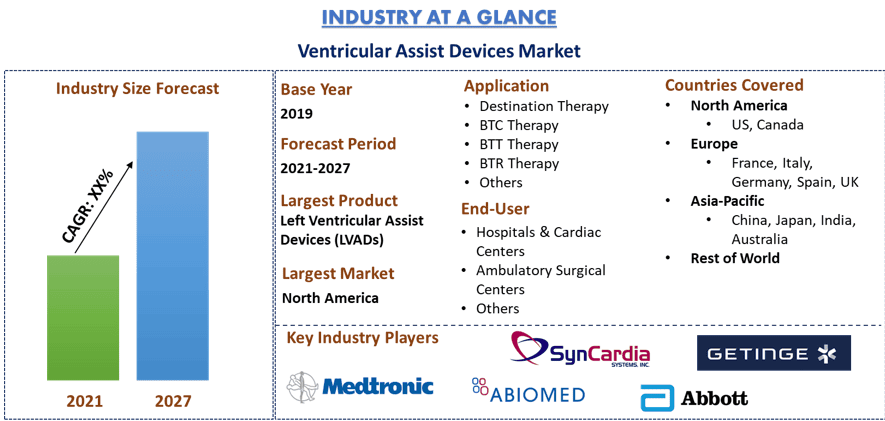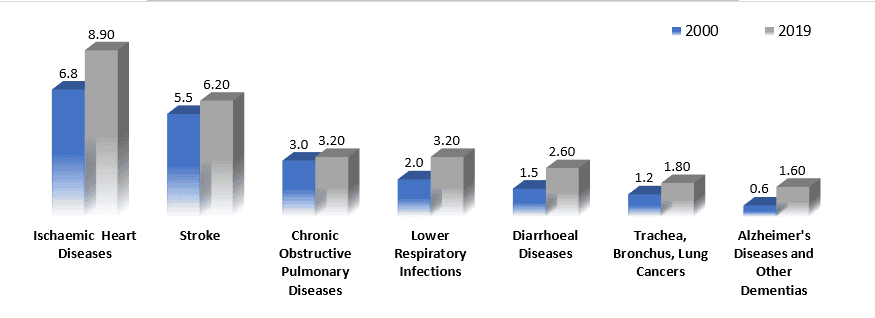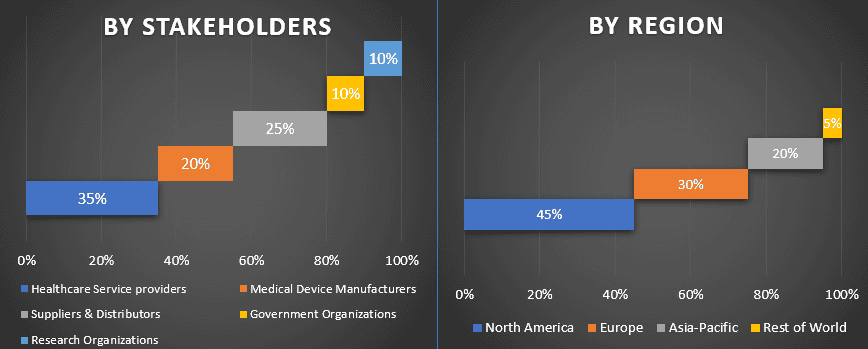補助人工心臓(VAD)市場:現状分析と予測(2021年~2027年)
製品の重点分野[左心室補助人工心臓(LVAD)、右心室補助人工心臓(RVAD)、両心室補助人工心臓(BIVAD)、経皮的補助人工心臓(PVAD)、完全人工心臓(TAH)];用途(Destination Therapy、Bridge-to-Candidacy(BTC) Therapy、Bridge-to-Transplant(BTT) Therapy、Bridge-to-Recovery(BTR) Therapy、その他);フロー(連続フロー、拍動フロー);設計(経皮的、植込み型);エンドユーザー(病院および心臓センター、外来手術センター、その他);地域および国。
補助人工心臓は、心臓が弱い患者が手術や心臓移植から回復するのを助けるために必要とされます。例えば、アボットは2020年2月18日、新しい製品「Gallant」である植込み型除細動器(ICD)および心臓再同期療法除細動器(CRT-D)デバイスについて、CEマークを取得したと発表しました。これは、心血管疾患を持つ人々に、最先端の心臓リズム管理機能と新たな利点をもたらすものです。さらに、患者が好むデザイン、改善されたバッテリー寿命、MRI互換性も提供します。また、心血管疾患の症例の急増が、成長する市場を加速させています。世界保健機関(WHO)によると、心血管疾患は世界的な死亡原因の第1位であり、2019年には約1,860万人が死亡しました。
さらに、高度な製品開発への投資の増加と、絶え間ない研究活動も、補助人工心臓の需要の成長を加速させています。例えば、汎用性の高い経皮的コプレーナエネルギー伝送(CET)システムの開発者である「Leviticus Cardio」は、左室補助人工心臓(LVAD)のグローバルリーダーである「Jarvik Heart」と協力し、イスラエル・米国バイナショナル産業研究開発(BIRD)財団から95万ドルの助成金を受けました。さらに、デバイスにおける技術革新の高まりも、世界的に補助人工心臓の成長を促進しています。例えば、2018年1月、グローバルな医療機器メーカーであるInternational Biophysicsは、世界最小の遠心ポンプであるFloPump 32について、FDA 510kクリアランスを取得しました。これは、Maquet RotaFlowコンソールとの組み合わせで使用するように設計および提案されています。
また、COVID-19のパンデミックは、心臓リズム管理デバイス市場を含むすべての業界にさまざまな影響を与えました。例えば、COVID-19の発生により、FDAは、肺塞栓症(PE)を含む心不全または脳卒中を患っているCOVID患者を治療するために、補助人工心臓を製造する企業に緊急使用許可(EUA)を与えました。2020年8月、「Abiomed」は、ECMO治療を受けているCOVID-19患者に左室サポートを提供するために、左側のImpella心臓ポンプについて、FDAから緊急使用許可(EUA)を受けました。また、同社は、COVID-19関連の右心不全または脳卒中を患っている患者を治療するために、「Impella RP」について、FDAからEUAを受けました。これらの開発は、補助人工心臓市場の著しい成長に役立ちました。
世界の主な死因、疾患別、(百万人)、2000年および2019年
Medtronic PLC、Abbott Laboratories、Berlin Heart GmbH、Reliant Heart Inc.、Abiomed Inc.、テルモ株式会社、Angiodroid、SynCardia Systems、CardiacAssist, Inc.、Getingeは、世界の補助人工心臓市場で活動している主要なプレーヤーの一部です。これらのプレーヤーは、ハイテクで革新的な製品を顧客に提供するために、いくつかのM&Aやパートナーシップを実施しています。
レポートで提示されるインサイト
「製品別では、左室補助人工心臓(LVAD)セグメントが主要なシェアを占めています」
製品に基づいて、市場は左室補助人工心臓(LVAD)、右室補助人工心臓(RVAD)、両室補助人工心臓(BIVAD)、経皮的補助人工心臓(PVAD)、および完全人工心臓(TAH)に二分されます。左室補助人工心臓(LVAD)セグメントは、2020年に市場を支配しました。ほとんどの場合、左室補助人工心臓(LVAD)が患者に使用されるためです。これは心不全の患者に移植され、心臓の左下の部屋(左心室)が心室から大動脈および体の残りの部分に血液を送り出すのを助けます。
「アプリケーション別では、デスティネーションセラピーセグメントが分析期間中に最高のCAGRで成長すると予想されます」
アプリケーションに基づいて、市場はデスティネーションセラピー、ブリッジ・トゥ・キャンディデシー(BTC)療法、ブリッジ・トゥ・トランスプラント(BTT)療法、ブリッジ・トゥ・リカバリー(BTR)療法、およびその他に二分されます。デスティネーションセラピーセグメントは、2020年に主要な収益部分を占めました。移植についての意識の高まりと、デスティネーションセラピーのための補助人工心臓の入手可能性によるものです。
「フロー別では、連続フローセグメントが主要なシェアを占めています」
フローに基づいて、市場は連続フローと脈動フローに二分されます。連続フローセグメントは、2020年に主要な収益部分を占めました。小型、長寿命、高エネルギー効率、低血栓性、および外科的侵襲の少なさによるものです。
「デザイン別では、植込み型セグメントが分析期間中に最高のCAGRで成長すると予想されます」
デザインに基づいて、市場は経皮的および植込み型に二分されます。植込み型セグメントは、2020年に主要な収益部分を占めました。植込み型補助人工心臓は、心臓移植の資格がない患者が長期的な治療法を好む傾向を高め、生存の可能性を高めるために主に使用されるためです。
「エンドユーザー別では、病院および心臓センターセグメントが主要なシェアを占めています」
エンドユーザーに基づいて、市場は病院および心臓センター、外来手術センター、およびその他に二分されます。病院および心臓センターセグメントは、有利な成長を示すと予想されます。患者に優れたケアを提供し、手術中に補償を提供するためです。
「北米は、補助人工心臓市場の最大の市場の1つを示しています」
補助人工心臓市場の市場ダイナミクスをよりよく理解するために、北米(米国、カナダ、および北米の残りの部分)、ヨーロッパ(ドイツ、フランス、イタリア、スペイン、英国、およびヨーロッパの残りの部分)、アジア太平洋(中国、日本、インド、オーストラリア、およびAPACの残りの部分)、および世界の残りの部分を含む、世界中のさまざまな地域で詳細な分析が実施されました。北米は補助人工心臓市場の主要な市場を構成しており、主要企業の存在と医療インフラストラクチャ、およびこの地域における心血管疾患患者の増加により、2020年に最大の収益を生み出しました。
このレポートを購入する理由:
- この調査には、認証された主要な業界専門家によって検証された市場規模と予測分析が含まれています
- レポートは、全体的な業界パフォーマンスの簡単なレビューを一目で示しています
- レポートは、主要なビジネス財務、製品ポートフォリオ、拡張戦略、および最近の動向に重点を置いた、著名な業界ピアの詳細な分析を網羅しています
- 業界に存在する推進要因、制約、主要なトレンド、および機会の詳細な調査
- この調査は、さまざまなセグメントにわたる市場を包括的に網羅しています
- 業界の地域レベル分析の詳細な調査
カスタマイズオプション:
補助人工心臓市場は、要件またはその他の市場セグメントに応じてさらにカスタマイズできます。これに加えて、UMIは、お客様が独自のビジネスニーズを持っている可能性があることを理解しているため、お客様の要件に完全に適合するレポートを入手するために、お気軽にお問い合わせください。
目次
世界の補助人工心臓市場の過去の市場分析、現在の市場の推定、および将来の市場予測は、世界の主要地域におけるさまざまなセグメントでの補助人工心臓の採用を創出し、分析するために実施された3つの主要なステップでした。過去の市場数値を収集し、現在の市場規模を推定するために、徹底的な二次調査が実施されました。次に、これらの洞察を検証するために、多数の調査結果と仮定が考慮されました。さらに、補助人工心臓セクターのバリューチェーン全体にわたる業界の専門家との徹底的な主要インタビューも実施されました。主要なインタビューを通じて市場数の仮定と検証を行った後、完全な市場規模を予測するためにトップダウン/ボトムアップアプローチを採用しました。その後、市場の内訳とデータ三角測量法を採用して、業界が関係するセグメントとサブセグメントの市場規模を推定および分析しました。詳細な方法論は以下に説明されています。
過去の市場規模の分析
ステップ1:二次ソースの詳細な調査:
年次報告書と財務諸表、業績プレゼンテーション、プレスリリースなどの企業内ソース、およびジャーナル、ニュースと記事、政府刊行物、競合他社の刊行物、セクターレポート、サードパーティデータベース、その他の信頼できる刊行物などの外部ソースを通じて、補助人工心臓の過去の市場規模を取得するために、詳細な二次調査が実施されました。
ステップ2:市場セグメンテーション:
補助人工心臓市場の過去の市場規模を取得した後、主要地域のさまざまなセグメントに関する過去の市場の洞察とシェアを収集するために、詳細な二次分析を実施しました。レポートに含まれる主なセグメントは、製品、アプリケーション、フロー、デザイン、およびエンドユーザーです。さらに、すべての地域における補助人工心臓の全体的な採用を評価するために、国レベルの分析が実施されました。
ステップ3:要因分析:
さまざまなセグメントとサブセグメントの過去の市場規模を取得した後、補助人工心臓の現在の市場規模を推定するために、詳細な要因分析を実施しました。さらに、心臓病患者の有病率の増加や心臓移植プロセスの待ち時間の長期化など、従属変数と独立変数を使用して要因分析を実施し、補助人工心臓の需要を増加させます。世界の補助人工心臓業界におけるトップパートナーシップ、合併と買収、事業拡大、および製品発売を考慮して、需要と供給側のシナリオについて徹底的な分析が実施されました。
現在の市場規模の推定と予測
現在の市場規模の決定:上記の3つのステップからの実用的な洞察に基づいて、現在の市場規模、補助人工心臓市場の主要なプレーヤー、およびセグメントの市場シェアに到達しました。必要なパーセンテージシェアの分割と市場の内訳はすべて、上記の二次アプローチを使用して決定され、主要なインタビューを通じて検証されました。
推定と予測:市場の推定と予測では、利害関係者が利用できる推進要因とトレンド、制約、および機会を含むさまざまな要因に重みが割り当てられました。これらの要因を分析した後、主要な市場全体でさまざまなセグメントとサブセグメントについて2027年頃の市場予測に到達するために、関連する予測手法、つまりトップダウン/ボトムアップアプローチが適用されました。市場規模の推定に採用された調査方法論には、以下が含まれます。
- 価値(米ドル)の面での業界の市場規模、および国内の主要市場における補助人工心臓の採用率
- 市場セグメントとサブセグメントのすべてのパーセンテージシェア、分割、および内訳
- 提供されるサービスに関して、補助人工心臓市場の主要なプレーヤー。また、急速に成長する市場で競争するためにこれらのプレーヤーが採用した成長戦略
市場規模とシェアの検証
一次調査:主要な地域全体のトップレベルのエグゼクティブ(CXO/VP、営業責任者、マーケティング責任者、運用責任者、および地域責任者、国責任者など)を含む主要なオピニオンリーダー(KOL)との詳細なインタビューが実施されました。一次調査の結果が要約され、統計分析が実行されて、述べられた仮説が証明されました。一次調査からのインプットは二次調査の結果と統合され、その結果、情報が実用的な洞察に変わりました。
さまざまな地域における一次参加者の分割
市場エンジニアリング
データ三角測量法を採用して、市場全体の推定を完了し、補助人工心臓市場の各セグメントとサブセグメントの正確な統計数値を導き出しました。データは、補助人工心臓市場の製品、アプリケーション、フロー、デザイン、およびエンドユーザーの分野におけるさまざまなパラメータとトレンドを調査した後、いくつかのセグメントとサブセグメントに分割されました。
補助人工心臓市場調査の主な目的
補助人工心臓の現在および将来の市場動向が調査で特定されました。投資家は、調査で実施された定性的および定量的分析から、投資の裁量に基づく戦略的洞察を得ることができます。現在および将来の市場動向は、地域レベルでの市場全体の魅力を決定し、産業参加者が未開拓の市場を活用して先行者利益として利益を得るためのプラットフォームを提供しました。調査のその他の定量的な目標には、以下が含まれます。
- 価値(米ドル)の面で、補助人工心臓の現在および予測市場規模を分析します。また、さまざまなセグメントとサブセグメントの現在および予測市場規模を分析します
- 調査のセグメントには、製品、アプリケーション、フロー、デザイン、およびエンドユーザーの分野が含まれます
- 補助人工心臓業界の規制枠組みを定義し、分析します
- さまざまな仲介業者の存在に伴うバリューチェーンを分析するとともに、業界の顧客と競合他社の行動を分析します
- 主要な地域の補助人工心臓市場の現在および予測市場規模を分析します
- レポートで調査された主要な地域には、北米(米国およびカナダ)、ヨーロッパ(ドイツ、フランス、イタリア、スペイン、および英国)、アジア太平洋(中国、日本、インド、およびオーストラリア)、および世界のその他の地域が含まれます
- 補助人工心臓市場の企業プロファイル、および急速に成長する市場で生き残るために市場プレーヤーが採用した成長戦略
- 業界の詳細な地域レベル分析
関連 レポート
この商品を購入したお客様はこれも購入しました













